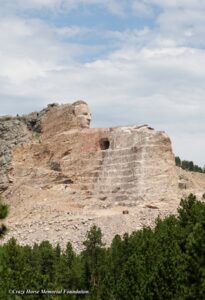 (…fourth in a series)
(…fourth in a series)
It’s easy to spot the rock carving of Crazy Horse’s face while traveling Highway 385 in Custer County, South Dakota. If that’s not irony, I don’t know what is.
Who, exactly, was Crazy Horse? And what’s the story behind the colossal carving that will, when complete, show him riding his steed straight out of the granite of the sacred Black Hills? The short answer is that Crazy Horse was a Lakota Sioux warrior, born around 1840 somewhere near modern-day Rapid City. On June 25, 1876, he led 1500 Lakota and Cheyenne warriors against General George Armstrong Custer’s U.S. Seventh Calvary at the Battle of Little Bighorn, also known as Custer’s Last Stand. Thirty-two Indians were killed in that fight. Two hundred and eighty enlisted U.S. soldiers and nine officers, including Custer himself, lay dead when the battle was over.
But the victory celebration among the native people was short-lived. The U.S. government soon rounded up the Northern Plains tribes and marched those who didn’t die of exposure or starvation (by then the great herds of bison were gone) to reservations.
In September 1877, under a flag of truce, Crazy Horse traveled to Fort Robinson, Nebraska. Negotiations with Army officers soon broke down, perhaps because of translation difficulties. A scuffle ensued and Crazy Horse was mortally wounded by an infantry guard with a bayonet. His family retrieved his body from the fort but, to this day, no one knows where his remains are laid to rest.
I read all this and more in “Crazy Horse: A Life” by Larry McMurtry, which I happened upon in a gift shop in South Dakota. McMurtry is one of my favorite writers and I enjoyed the short biography on the plane ride home. I learned that Crazy Horse had lighter skin than most of the Sioux people and that his hair was curly. An introspective youth, he cherished time alone, when he could fast and think. But he proved himself a capable and brave warrior at a young age, riding into battle with a single hawk feather in his hair, a rock behind his left ear and the symbol of a lightning bolt painted on his face.
He refused to ever have his picture taken, believing that part of his soul would be lost to the photograph.
In the early 1940s, Lakota Chief Henry Standing Bear began the search for a sculptor to create a carving of Crazy Horse. It would be as large in scope and vision as Mount Rushmore and would honor all the indigenous people of North America. Sculptor Korczak Ziolkowski was chosen. He began the project in 1948. Because there are no pictures of Crazy Horse, the likeness Ziolkowski created was inspired by descriptions by those who had known him.
The Crazy Horse Memorial now includes the still-in-progress carving, the Native American Educational and Cultural Center and the Ziolkowski home and studio. The memorial is sustained through admission fees and charitable gifts. It receives no government funding. Second and third generation Ziolkowski family members continue to work to keep the dream alive.
Crazy Horse’s granite head was completed in 1998, 50 years after it was begun. His left hand is taking shape, with an index finger 29 feet long. So…how many years will it take to finish the entire carving? No one knows. It’s expensive and painstakingly slow work. Some say the carving won’t be completed for decades. Others say centuries. Naysayers predict it will never be completed. But if and when it is, the carving will be 563 feet high and 641 feet long, the largest statue on Planet Earth.
No one reading this column will likely live to see it. But more than a million tourists visit the Crazy Horse Memorial every year to gaze in wonder at the image of the man deservedly chosen to symbolize the strength, courage and tragic history of this nation’s indigenous people.
(September 28, 2024)